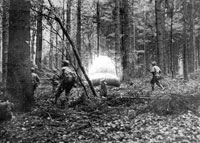Mystery of Kecksburg UFO incident lost in NASA archives for good
Leonard David, an observer of one of the largest space exploration websites, space.com, updated his blog with new details about the investigation of a mysterious incident which took place in USA’s Pennsylvania. The National Aeronautics and Space Administration (NASA) has lost the case vs. journalist Leslie Kean about violating the principles of freedom of information.

Leslie Kean had been investigating the mystery of the Kecksburg UFO incident for four years. An unidentified flying object supposedly crashed not far from a small village in Pennsylvania in December 1965. Eyewitnesses of the incident said that they could see a ball of fire in the night sky. Some of them said that the object had performed a controlled landing.
Local newspapers and radio channels reported that military men encircled the area of the incident, conduct the investigation and then left without any explanations. However, rumor has it that spokespeople for local authorities had visited the site of the UFO crash before the military men arrived. They said that the object, which either crashed or landed in Kecksburg, was an acorn-like object the size of a baby car. The body of the object was covered with inscriptions reminiscent of Egyptian hieroglyphs.
NASA provided packs of documents to Leslie Kean prior to the trial, but the documents had nothing to do with the case. It was obvious, which made Judge Emmet Sullivan agree on that. The judge’s refusal to close the case pushed NASA towards looking for more reliable.
The trial took place in October 2007. Leslie Kean received 297 boxes with various data from NASA only last week. The journalist randomly picked some of the documents she found in the box to see what kind of information the boxes contained. Some of those documents describe NASA’s and US Navy’s rescue operations, photographs of the orbit and data about the launches of Soviet rockets from 1963 to 1965. Other documents give detailed specifications of contacts between the US Department of Defense and NASA.
The Kecksburg UFO incident of Kecksburg, Pennsylvania, USA occurred on December 9, 1965. A large, brilliant fireball was seen by thousands in at least six states and Ontario, Canada. It streaked over the Detroit, Michigan/Windsor, Ontario area, dropped reported metal debris over Michigan and northern Ohio, and caused sonic booms in western Pennsylvania. It was generally assumed and reported by the press to be a meteor.
However, eyewitnesses in the small village of Kecksburg, about 30 miles southeast of Pittsburgh, claimed something crashed in the woods. A boy said he saw the object land; his mother saw a wisp of blue smoke arising from the woods and alerted authorities. Others from Kecksburg, including local volunteer fire department members, reported finding an object in the shape of an acorn and about as large as a Volkswagen Beetle. Writing resembling Egyptian hieroglyphics was also said to be in a band around the base of the object. Witnesses further reported that intense military presence, most notably Army, secured the area, ordered civilians out, and then removed the object on a flatbed truck. At the time, however, the military claimed they searched the woods and found "absolutely nothing."
The nearby Greensburg Tribune-Review had a reporter at the scene; the headline in the newspaper the next day was "Unidentified Flying Object Falls near Kecksburg — Army Ropes off Area."
The official explanation of the widely-seen fireball was a mid-sized meteor, however, speculation as to what the Kecksburg object had been (if there was one — reports vary) also range from it being an alien craft to the remains of an unmanned Soviet Venera 4 atmospheric probe, also known as Kosmos-96, originally destined for Venus. (However, see below where this was recently ruled out by NASA's chief in charge of tracking orbital debris.)
In December 2005, just before the Kecksburg crash 40th anniversary, NASA released a statement to the effect that they had examined metallic fragments from the object and now claimed it was from a re-entering "Russian satellite." The spokesman further claimed that the related records had been misplaced. According to an Associated Press story:
The object appeared to be a Russian satellite that re-entered the atmosphere and broke up. NASA experts studied fragments from the object, but records of what they found were lost in the 1990s.
The claim contradicts what journalist Leslie Kean was told in 2003 by Nicholas L. Johnson, NASA's chief scientist for orbital debris. As part of the new Sci Fi investigation, Kean had Johnson recheck orbital paths of all known satellites and other records from the period in 1965. Johnson told Kean that orbital mechanics made it absolutely impossible for any part of the Cosmos 96 Venus probe to account for either the fireball or any object at Kecksburg. Johnson also stated there were no other manmade satellites or other objects that re-entered the atmosphere on that day.
Thus, this raises the question as to what "Russian satellite" could account for the debris that NASA now admits they examined. Furthermore, Kean and others deem it highly questionable that NASA could actually lose such records. In December 2005, a lawsuit was filed to get NASA to search more diligently for the alleged lost records.
On October 26, 2007, NASA agreed to search for those records after being ordered by the court. The judge, who had tried to move NASA along for more than 3 years, angrily referred to NASA's previous search efforts as a "ball of yarn" that never fully answered the request, adding, "I can sense the plaintiff's frustration because I'm frustrated."
During the hearing, Steve McConnell, NASA's public liaison officer, admitted two boxes of papers from the time of the Kecksburg incident were missing. Stan Gordon, principle investigator of the Kecksburg incident for several decades, stated "I have no doubt the government knows a lot more about this than it has revealed to the public."
Subscribe to Pravda.Ru Telegram channel, Facebook, RSS!


